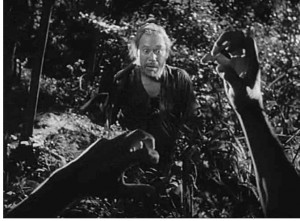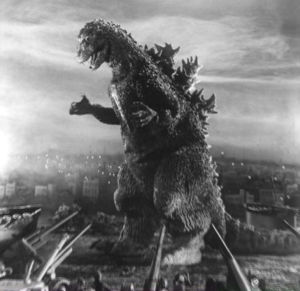There have been numerous 'epochs' in cinema, so to speak, but I feel as if there has been none more complete and personally rewarding as the Golden Age of Japanese Cinema. The general consensus is that the 'golden' period lasted no more than thirty years, approximately from the mid 1940s (post-WWII Japan) up until the mid-to-late 1960s. It is staggering how many great films came from this period.
Firstly, you had a bunch of Yasujiro Ozu films, including two of my all-time favourite masterworks, Late Spring and Tokyo Story. These films are timeless and human observations into the postwar institution of marriage and family, and how the former, in particular, can be seen as a social constraint, designed to reinstill male hegemony after a losing war. They also seemed to place great emphasis on the role of independent women, something that was not too particularly prevalent in cinema at the time.

Late Spring (1949)
Secondly, this age arguably marked the greatest period in Akira Kurosawa's prolific career, with films such as Rashomon that proved to be the first internationally recognised and popular Japanese piece in the West. We also got Ikiru, High and Low, The Bad Sleep Well, Seven Samurai, Yojimbo, Throne of Blood etc, etc. Best of all, Kurosawa was forking out films left, right, and centre. He was on a roll.

Rashomon (1950)
Then along came Mizoguchi with his three notable tales - Sansho the Bailiff, The Life of Oharu, and Ugetsu. His films really seemed to adopt a sweepingly poetic aesthetic that we did not always necessarily see in Ozu or Kurosawa films. Even more amazingly, these films were all released within a time span of 4 years. Like Kurosawa, he, too, was on a roll, if only for a short amount of time.

Sansho the Bailiff (1954)
We also saw the birth of iconic classics such as Godzilla, which was a critical and commercial success not only in Japan but eventually around the world. Moreover, along came the radical Masaki Kobayashi, who defied the status-quo and made constantly daring films, such as the Human Condition trilogy (which is nine and a half hours in its entirety).

Godzilla (1954)
But wait, there's more. Kon Ichikawa gave us Fires on the Plain, a harrowing anti-war film and one of the best that showed the complete disarray of WWII from a Japanese perspective. He also gifted us with the poetical The Burmese Harp. Mikio Naruse made Floating Clouds, and, towards the end of the Golden Age period, we also saw the growing presence of Seijun Suzuki and Shohei Imamura.

Fires on the Plain (1959)
And perhaps best of all, there are a ton of other films and filmmakers from this great period too. So many I have yet to see and probably never heard of. So many that are only recently getting the restorations and distributions they deserve. What are your favourite films and/or filmmakers from this period? Do you have any recommendations? Any comments in general? I just love this particular time period in Japanese cinema and would love to hear your two cents on anything related to it. Sorry for rambling, but the sheer amount of greatness that was derived from such a relatively small time is truly something in my eyes.
Firstly, you had a bunch of Yasujiro Ozu films, including two of my all-time favourite masterworks, Late Spring and Tokyo Story. These films are timeless and human observations into the postwar institution of marriage and family, and how the former, in particular, can be seen as a social constraint, designed to reinstill male hegemony after a losing war. They also seemed to place great emphasis on the role of independent women, something that was not too particularly prevalent in cinema at the time.

Late Spring (1949)
Secondly, this age arguably marked the greatest period in Akira Kurosawa's prolific career, with films such as Rashomon that proved to be the first internationally recognised and popular Japanese piece in the West. We also got Ikiru, High and Low, The Bad Sleep Well, Seven Samurai, Yojimbo, Throne of Blood etc, etc. Best of all, Kurosawa was forking out films left, right, and centre. He was on a roll.

Rashomon (1950)
Then along came Mizoguchi with his three notable tales - Sansho the Bailiff, The Life of Oharu, and Ugetsu. His films really seemed to adopt a sweepingly poetic aesthetic that we did not always necessarily see in Ozu or Kurosawa films. Even more amazingly, these films were all released within a time span of 4 years. Like Kurosawa, he, too, was on a roll, if only for a short amount of time.

Sansho the Bailiff (1954)
We also saw the birth of iconic classics such as Godzilla, which was a critical and commercial success not only in Japan but eventually around the world. Moreover, along came the radical Masaki Kobayashi, who defied the status-quo and made constantly daring films, such as the Human Condition trilogy (which is nine and a half hours in its entirety).

Godzilla (1954)
But wait, there's more. Kon Ichikawa gave us Fires on the Plain, a harrowing anti-war film and one of the best that showed the complete disarray of WWII from a Japanese perspective. He also gifted us with the poetical The Burmese Harp. Mikio Naruse made Floating Clouds, and, towards the end of the Golden Age period, we also saw the growing presence of Seijun Suzuki and Shohei Imamura.

Fires on the Plain (1959)
And perhaps best of all, there are a ton of other films and filmmakers from this great period too. So many I have yet to see and probably never heard of. So many that are only recently getting the restorations and distributions they deserve. What are your favourite films and/or filmmakers from this period? Do you have any recommendations? Any comments in general? I just love this particular time period in Japanese cinema and would love to hear your two cents on anything related to it. Sorry for rambling, but the sheer amount of greatness that was derived from such a relatively small time is truly something in my eyes.
Last edited by Matteo; 01-27-14 at 05:45 PM.
Reason: I made an error in the title of this thread, but it doesn't appear to change when I edit it.